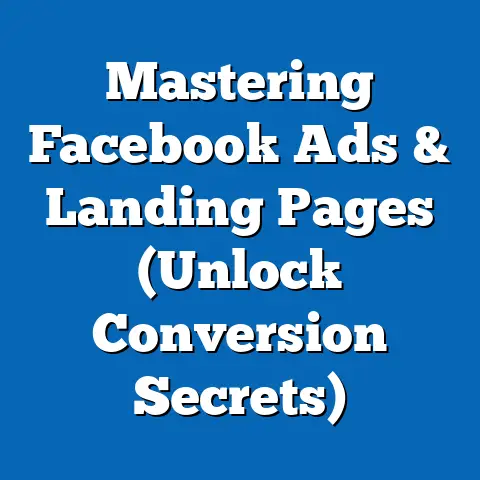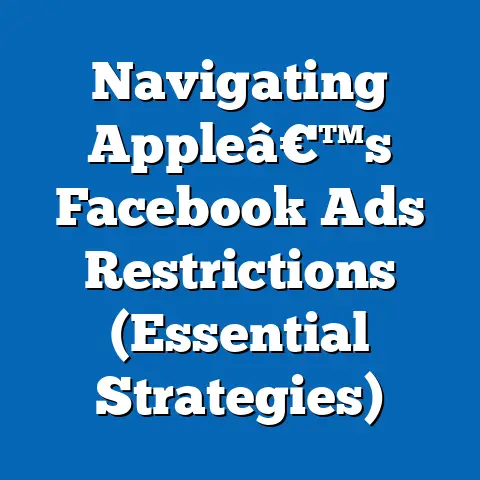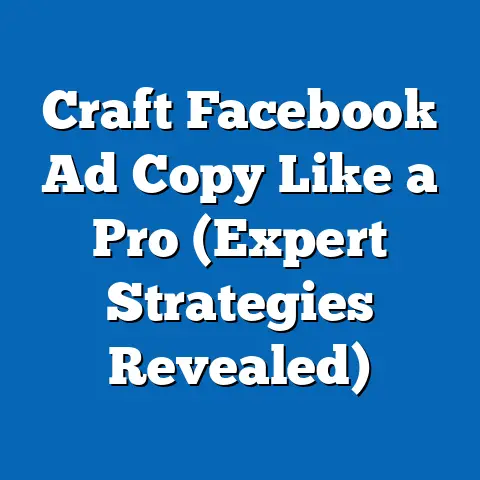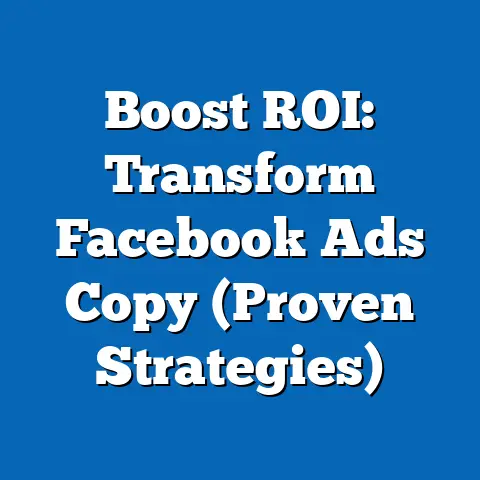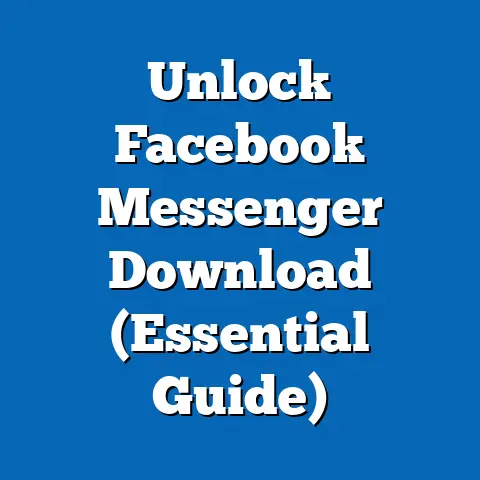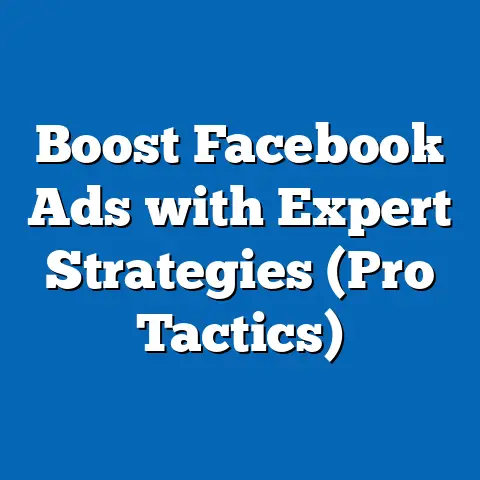Boost Leads Fast with Facebook Ads (Expert Comparison Guide)
I remember when I first started out in marketing, the struggle to generate leads felt like pushing a boulder uphill. Cold calls, email blasts, and traditional advertising felt like throwing spaghetti at the wall, hoping something would stick. Weeks would go by with minimal results, and I felt like I was constantly spinning my wheels. Then, I discovered the power of Facebook Ads. I remember setting up my first campaign, targeting a specific demographic with a compelling offer, and within hours, leads started pouring in. It was like flipping a switch. That’s when I realized the immense potential Facebook Ads held for rapid lead generation, and I want to share that knowledge with you.
In today’s digital age, speed is everything. Businesses need to generate leads quickly and efficiently to stay ahead of the competition. Facebook Ads offer a powerful solution, providing unparalleled targeting capabilities and measurable results. This guide will walk you through the ins and outs of Facebook Ads, comparing expert strategies and helping you avoid common pitfalls, so you can start boosting your leads today.
Understanding Facebook Ads
Facebook Ads are a paid advertising platform that allows businesses to display ads to users on Facebook, Instagram, and the Audience Network. These ads can be tailored to reach specific demographics, interests, and behaviors, making them incredibly effective for lead generation.
The beauty of Facebook Ads lies in its precision. Unlike traditional advertising methods that rely on broad reach, Facebook Ads allow you to target your ideal customers with pinpoint accuracy. This means you’re not wasting your budget on reaching people who aren’t interested in your product or service.
Benefits of Using Facebook Ads for Lead Generation:
- Targeted Reach: As I mentioned, Facebook’s targeting capabilities are unmatched. You can target users based on demographics (age, gender, location), interests (hobbies, passions, favorite brands), behaviors (purchase history, online activity), and even their connections (friends of people who like your page).
- Cost-Effectiveness: Facebook Ads can be incredibly cost-effective, especially compared to traditional advertising. You set your own budget and can adjust it at any time. Plus, you only pay when someone takes a specific action, such as clicking on your ad or filling out a lead form.
- Measurable Results: Unlike traditional advertising, Facebook Ads provide detailed analytics that allow you to track your performance and optimize your campaigns. You can see exactly how many people are seeing your ads, clicking on them, and converting into leads.
- Variety of Ad Formats: Facebook offers a variety of ad formats to suit different business needs and marketing goals.
Popular Ad Formats for Lead Generation:
- Image Ads: Simple and effective, image ads are a great way to showcase your product or service with a visually appealing image and compelling copy.
- Video Ads: Video ads are highly engaging and can be used to tell a story, demonstrate your product, or provide valuable information. They are especially effective at capturing attention and generating interest.
- Carousel Ads: Carousel ads allow you to showcase multiple images or videos in a single ad, making them perfect for highlighting different features of your product or service or telling a multi-part story.
- Lead Ads: Lead ads are specifically designed for lead generation. They allow users to fill out a form directly within the ad, making it incredibly easy for them to provide their contact information.
Takeaway: Facebook Ads offer a powerful and cost-effective way to generate leads by targeting your ideal customers with precision and measuring your results. The variety of ad formats available allows you to tailor your campaigns to different business needs and marketing goals.
Setting Up Your First Facebook Ad Campaign
Getting started with Facebook Ads can seem daunting, but it’s actually quite straightforward. Here’s a step-by-step guide to setting up your first campaign specifically designed for lead generation:
- Create a Facebook Ads Account: If you don’t already have one, you’ll need to create a Facebook Ads account. You can do this by going to Facebook Ads Manager (business.facebook.com) and following the instructions.
- Navigate to Ads Manager: Once you have an account, navigate to the Ads Manager. This is where you’ll create and manage your ad campaigns.
- Create a New Campaign: Click on the “Create” button to start a new campaign.
- Choose Your Campaign Objective: This is arguably the most important step. Facebook offers various campaign objectives, but for lead generation, you’ll want to choose “Lead Generation.” This objective tells Facebook that you want to collect contact information from potential customers.
- Set Your Budget: Determine how much you’re willing to spend on your campaign. You can set a daily budget or a lifetime budget. I recommend starting with a smaller daily budget to test your ads and optimize your targeting before scaling up.
- Define Your Target Audience: This is where Facebook’s targeting capabilities come into play. Define your ideal customer by specifying their demographics, interests, behaviors, and connections. The more specific you are, the more effective your ads will be.
- Choose Your Ad Placement: Decide where you want your ads to appear. You can choose to show your ads on Facebook, Instagram, and the Audience Network. For lead generation, I recommend focusing on Facebook and Instagram, as these platforms tend to have higher engagement rates.
- Select Your Ad Format: Choose the ad format that best suits your business needs and marketing goals. As mentioned earlier, lead ads are specifically designed for lead generation.
- Craft Compelling Ad Copy: Write clear, concise, and compelling ad copy that highlights the benefits of your product or service and encourages users to take action. Use strong calls to action, such as “Learn More,” “Sign Up Now,” or “Get a Free Quote.”
- Create Attractive Visuals: Use high-quality images or videos that are visually appealing and relevant to your target audience. Your visuals should grab attention and communicate your message effectively.
- Set Up Your Lead Form: If you’re using lead ads, you’ll need to set up your lead form. This is the form that users will fill out to provide their contact information. Keep the form short and simple, asking only for the information you need.
- Review and Publish: Before publishing your campaign, review all of your settings to make sure everything is correct. Once you’re satisfied, click on the “Publish” button to launch your campaign.
Takeaway: Setting up a Facebook Ad campaign for lead generation involves defining your objective, setting your budget, targeting your audience, choosing your ad placement, crafting compelling ad copy, creating attractive visuals, and setting up your lead form. Remember to review all of your settings before publishing your campaign.
Expert Comparison of Facebook Ads Strategies
Now that you know the basics of setting up a Facebook Ad campaign, let’s dive into some expert strategies for maximizing lead generation.
Targeting Strategies
Targeting is the key to success with Facebook Ads. The more precisely you can target your ideal customers, the more effective your ads will be. Here’s a comparison of different targeting strategies:
- Custom Audiences: Custom Audiences allow you to target people who have already interacted with your business, such as website visitors, email subscribers, or customers. This is a great way to re-engage people who are already familiar with your brand. One of the most effective custom audiences I’ve used is a list of past webinar attendees. Re-engaging them with targeted offers resulted in a significant boost in lead conversions.
- Lookalike Audiences: Lookalike Audiences allow you to target people who are similar to your existing customers or website visitors. This is a great way to expand your reach and find new customers who are likely to be interested in your product or service. I’ve found that creating lookalike audiences based on my best-performing customer segments yields the highest quality leads.
- Detailed Targeting: Detailed Targeting allows you to target people based on their demographics, interests, behaviors, and connections. This is a great way to target a specific niche audience. For example, if you’re selling fitness equipment, you could target people who are interested in fitness, health, and wellness.
Which Strategies are Most Effective for Different Types of Businesses?
- E-commerce Businesses: Custom Audiences and Lookalike Audiences are particularly effective for e-commerce businesses. You can use Custom Audiences to re-target website visitors who abandoned their carts or to promote new products to existing customers. You can use Lookalike Audiences to find new customers who are similar to your best-performing customers.
- Service-Based Businesses: Detailed Targeting and Lead Ads are particularly effective for service-based businesses. You can use Detailed Targeting to target people who are interested in your services and Lead Ads to collect their contact information.
- Local Businesses: Location-based targeting is crucial for local businesses. Target people who live within a certain radius of your business location. You can also use Custom Audiences to target people who have visited your business in the past.
Ad Creative Strategies
The creative elements of your ads play a crucial role in their success. Here’s an analysis of the impact of different ad formats and creative elements on lead generation rates:
- Images vs. Videos: Videos tend to be more engaging than images, but they also require more effort to create. I’ve found that videos are particularly effective for capturing attention and telling a story, while images are better for showcasing a specific product or service. Remember that mobile users often watch videos without sound, so ensure your message is clear visually.
- Copy Length: Shorter ad copy tends to perform better than longer ad copy. People are more likely to read a short, concise message than a long, drawn-out one. I aim for copy that clearly communicates the value proposition in just a few sentences.
- Call-to-Action Buttons: The call-to-action button is one of the most important elements of your ad. Use strong calls to action that encourage users to take action, such as “Learn More,” “Sign Up Now,” or “Get a Free Quote.” A/B testing different CTAs can significantly improve conversion rates.
Insights from Industry Experts:
“The key to successful Facebook Ads is to focus on creating ads that are relevant and engaging to your target audience,” says Neil Patel, a renowned digital marketing expert. “Use high-quality images and videos, write compelling copy, and test different ad formats to see what works best for your business.”
Case Study:
A local restaurant wanted to generate more leads for their catering services. They created a Facebook Ad campaign targeting people who were interested in event planning and catering. They used a video ad showcasing their delicious food and excellent service. The ad copy highlighted the benefits of using their catering services for events. They used a strong call to action, “Get a Free Quote.” The campaign resulted in a 30% increase in leads for their catering services.
Optimization Strategies
Optimization is an ongoing process. You need to constantly monitor your performance and make adjustments to your campaigns to improve your results. Here’s a discussion of optimization strategies:
- A/B Testing: A/B testing is the process of testing different versions of your ads to see which one performs best. You can test different headlines, images, ad copy, and call-to-action buttons. I recommend testing one element at a time to isolate the impact of each change.
- Monitoring Metrics: It’s important to monitor your key metrics to track your performance and identify areas for improvement. Key metrics include click-through rate (CTR), conversion rate, and return on ad spend (ROAS). I personally prioritize ROAS, as it directly reflects the profitability of my campaigns.
- Adjusting Your Budget: If you’re seeing positive results, you can increase your budget to scale your campaigns. If you’re not seeing the results you want, you can decrease your budget or pause your campaigns.
Expert Opinions on Which Metrics to Prioritize:
“While click-through rate is important, it’s not the only metric you should be tracking,” says Gary Vaynerchuk, a social media marketing guru. “You should also be tracking conversion rates and return on ad spend. Ultimately, you want to focus on metrics that are directly tied to your business goals.”
Takeaway: Expert Facebook Ads strategies for maximizing lead generation include targeting your audience with precision, crafting compelling ad creatives, and optimizing your campaigns through A/B testing and monitoring key metrics.
Common Pitfalls and How to Avoid Them
Starting with Facebook Ads for lead generation can be challenging, and it’s easy to make mistakes. Here are some common pitfalls and how to avoid them:
- Not Targeting Your Audience Properly: This is one of the most common mistakes. If you’re not targeting your audience properly, you’re wasting your budget on reaching people who aren’t interested in your product or service. To avoid this, take the time to define your ideal customer and use Facebook’s targeting capabilities to reach them with precision.
- Using Poor-Quality Ad Creatives: Your ad creatives are the first thing people will see, so it’s important to make a good impression. Use high-quality images and videos that are visually appealing and relevant to your target audience. Avoid using blurry or pixelated images.
- Writing Weak Ad Copy: Your ad copy should be clear, concise, and compelling. Highlight the benefits of your product or service and encourage users to take action. Avoid using jargon or technical terms that your target audience won’t understand.
- Not Testing Your Ads: A/B testing is essential for optimizing your campaigns. Test different headlines, images, ad copy, and call-to-action buttons to see what works best for your business.
- Not Monitoring Your Performance: It’s important to monitor your key metrics to track your performance and identify areas for improvement. If you’re not monitoring your performance, you won’t know if your campaigns are working or not.
Expert Insights on How to Avoid These Pitfalls:
“The key to success with Facebook Ads is to be patient and persistent,” says Amy Porterfield, a social media marketing expert. “It takes time to find the right targeting, ad creatives, and optimization strategies. Don’t get discouraged if you don’t see results immediately. Keep testing and refining your campaigns until you find what works best for your business.”
Takeaway: Common pitfalls when starting with Facebook Ads for lead generation include not targeting your audience properly, using poor-quality ad creatives, writing weak ad copy, not testing your ads, and not monitoring your performance.
Conclusion
Facebook Ads are a powerful tool for boosting lead generation quickly and effectively. By understanding the basics of Facebook Ads, setting up your first campaign, comparing expert strategies, and avoiding common pitfalls, you can start generating leads and growing your business.
Remember, the key to success with Facebook Ads is to be patient, persistent, and willing to learn. The digital advertising landscape is constantly evolving, so it’s important to stay up-to-date on the latest trends and best practices. Embrace the power of Facebook Ads and watch your business thrive. Now, go out there and start creating some amazing campaigns!

